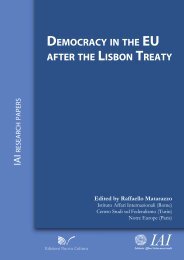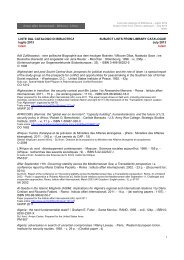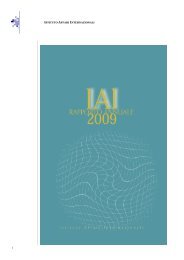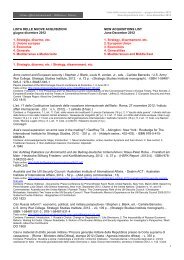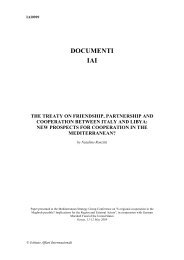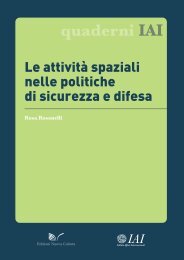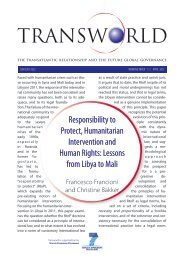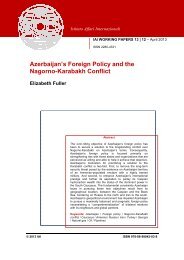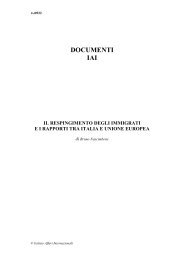La minaccia NBCR - Istituto Affari Internazionali
La minaccia NBCR - Istituto Affari Internazionali
La minaccia NBCR - Istituto Affari Internazionali
Create successful ePaper yourself
Turn your PDF publications into a flip-book with our unique Google optimized e-Paper software.
imported from Israel. Contaminated grapefruits were discovered in Naples and Rome and the<br />
government took all grapefruits off the market. The “poison” turned out to be a substance<br />
which causes colour tainting but is not harmful.” 19 .<br />
Ancora alcune recenti iniziative in ambito NATO testimoniano la realtà della <strong>minaccia</strong><br />
<strong>NBCR</strong>.<br />
E’ di aprile 2007 la notizia di un prototipo di dispositivo portatile sviluppato con la<br />
Federazione Russa e testato con successo per la rilevazione e la localizzazione di sostanze<br />
esplosive, R, N e C 20 .<br />
Meno recente, ma di interessante lettura, la relazione su “Rilevazione chimica, biologica,<br />
radiologica e nucleare” adottata dalla Commissione per la dimensione civile della sicurezza<br />
presso l’Assemblea parlamentare della NATO. Questa ultima descrive molto bene una<br />
questione rilevante della <strong>minaccia</strong> terroristica <strong>NBCR</strong>: ovvero il problema della sostenibilità<br />
delle emergenze generate anche da falsi allarmi: “(…) as information and capabilities<br />
become progressively more widespread via the Internet etc., it is becoming increasingly<br />
difficult for the authorities to distinguish between a mere hoax and the real thing. This raises<br />
a number of difficult questions about the appropriate responses to such threats, which not<br />
only have the potential to be extremely disruptive to normal, day-to-day activities, but also<br />
may provide individual terrorists and terrorist groups with a potent instrument against<br />
society, even in the absence of a real capability or willingness to carry out an actual attack. In<br />
any event, an attack using unconventional weapons would certainly cause serious economic<br />
and social disruption. According to a recent study by the Organisation of Economic Co-<br />
19 Other Group attacked Food or Water Supply target (Apr. 25, 1988, Italy), RAND - MIPT Terrorism<br />
knowledge base, http://www.tkb.org/Incident.jsp?incID=5540<br />
20 “(…) Named SENNA, the device could have a number of different applications. These include improving<br />
transport security by on-site analysis of suspicious containers or luggage; protecting critical infrastructure or<br />
public buildings by on-site detection at facilities; and promoting better security for troops deployed in crisismanagement<br />
operations by allowing on-site detection in the field. (…) The device is based on nanosecond<br />
neutron analysis technology and includes a compact neutron generator and an array of four gamma-ray and<br />
three neutron detectors. It is a multi-sensor – this means that when the neutron generator is off, it can detect and<br />
identify radioactive and unshielded nuclear materials, and when the neutron generator is on, it becomes a<br />
detector of explosives and chemical substances, as well as of heavily shielded nuclear materials. Due to the high<br />
penetrating ability of neutrons and high-energy gamma rays, the device can “see” through barriers and detect<br />
threat materials located inside unattended passenger luggage, transport containers, etc. The device is position<br />
sensitive – not only can it detect a hazardous material, it can also show its location inside the inspected object.”,<br />
NATO-Russia project for detecting “dirty bombs”, 30 May 2007, http://www.nato.int/docu/update/2007/05may/e0530b.html<br />
- 10 -





